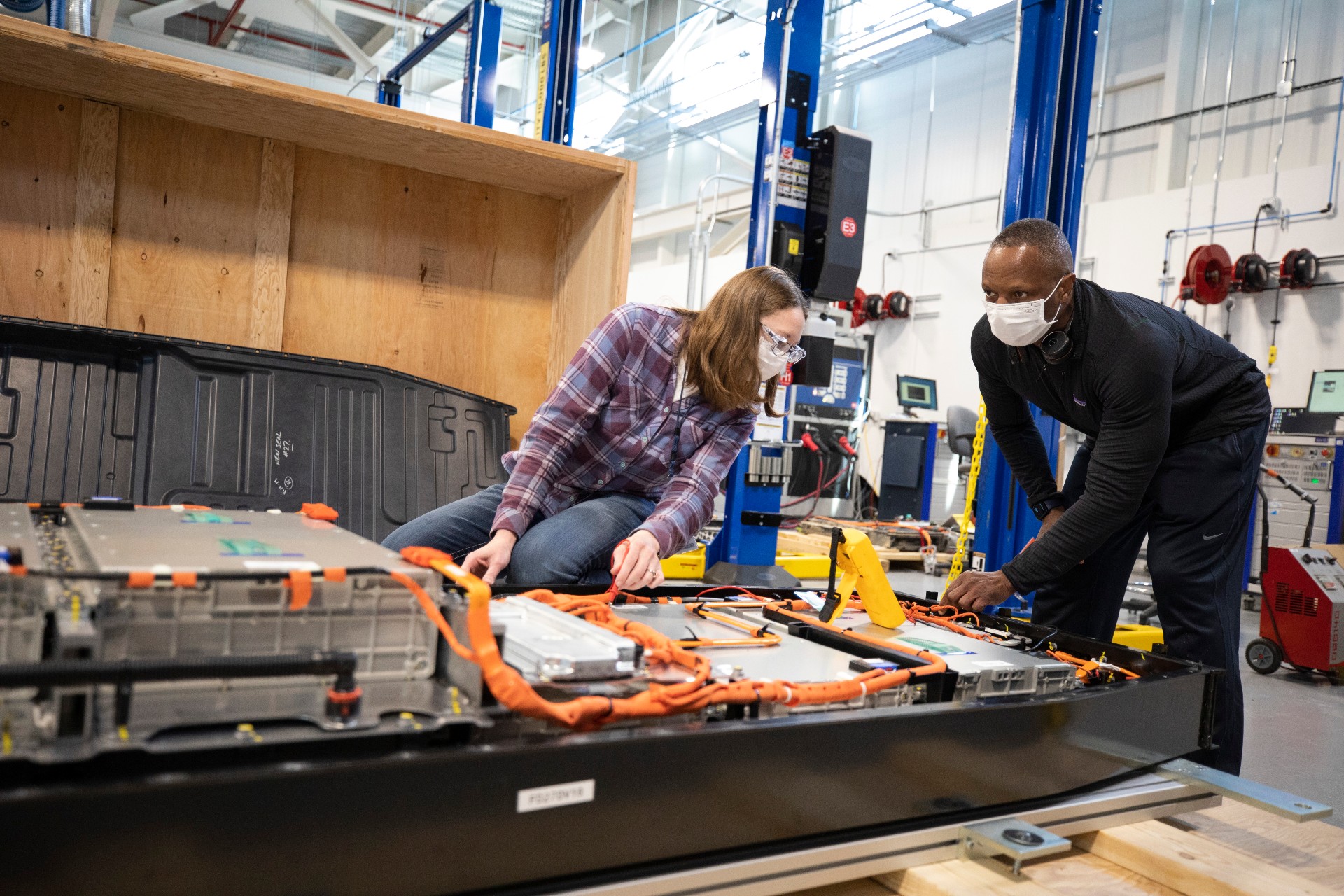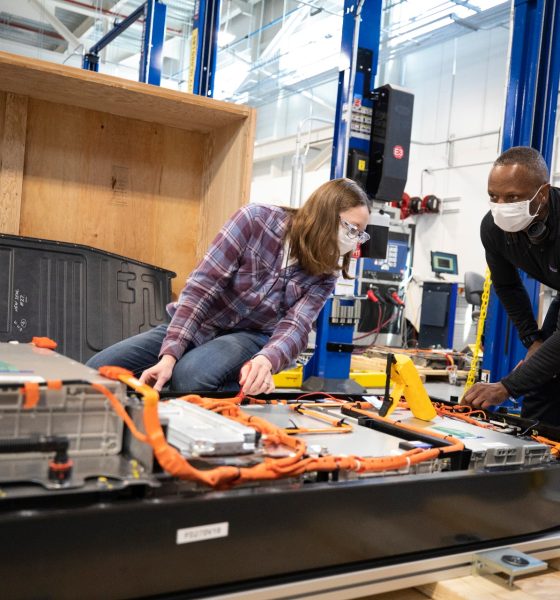

News
Ford signs joint venture with SK Innovation, backtracking its ‘no advantage’ battery stance
Ford has announced that it has signed a joint venture deal with South Korea’s SK Innovation in a monumental partnership that will manufacture EV battery cells in the United States. The announcement shows Ford has backtracked on its previous stance of manufacturing batteries in-house, after the company’s previous CEO Jim Hackett said there is “no advantage” to automakers building cells themselves.
Last night, Ford unveiled its F-150 Lightning pickup truck, an all-electric version of its highly-popular F-150 pickup that has dominated the U.S. truck market for years. Ford recently entered the electric vehicle sector with its Mustang Mach-E, a crossover that holds the legendary name of the muscle car that is synonymous with performance and aesthetics. Along with the Mustang Mach-E, Ford has unveiled the e-Transit van, an all-electric take on its chassis cab cargo van, and of course, the F-150 Lightning, which had its very public unveiling last night.
Now, Ford is making moves to increase battery cell supplies for its transition to electrification by entering a joint venture with SK Innovation. The venture will be called BlueOvalSK, and it was first reported by Reuters.
On the heels of a speech from President Joe Biden on Tuesday that outlined the importance of transitioning to electrification to not only fuel carbon neutralization efforts but also for secure American, unionized jobs, Ford is now taking extra steps to secure extra manufacturing jobs in its home country while aiming to avoid battery cell shortages.
Ford CEO Jim Farley told reporters on Wednesday night that “As the industry changes, we have to insource now.” Cells are the most important and most expensive portion of an electric car. A key way to reduce costs and remain more competitive in the EV sector is to produce cells through a partnership with suppliers or with a wholly-owned facility. Tesla does both, as the company purchases cells from LG Chem and CATL, and through a partnership with Panasonic at its Gigafactory Nevada site. Additionally, Tesla produces its own 4680 cells at the Kato Road facility in Northern California. These cells have yet to be installed into vehicles, but will be in the future and will decrease battery costs while increasing power, range, and efficiency.
Farley believes that the partnership will help avoid battery constraints for its vehicles, an issue that has plagued the automotive sector this year, except with semiconductors.
Interestingly, it is a major backtrack from what Ford’s former stance on battery production was. Last year, then-Ford CEO Jim Hackett commented on Tesla’s strategy to produce its own cells, stating it had “no advantage.”
Hackett said:
“I’ve met with a number of the people that you know that are in the supply side of this. And it was our estimation, in fact, our whole team went through a really deep dive on this six months ago, that the supply chain has ramped up since Elon built his Gigafactory. And so there’s plenty there that does not warrant us to migrate our capital into owning our own factory. There’s no advantage in the ownership in terms of cost or sourcing as what Ford can draw on.”
After Farley took the helm at Ford on October 1, 2020, he seemed to indicate that things were heading in a different direction than Hackett indicated. “Absolutely, we’re discussing it as a team,” when asked about Ford’s potential to produce its own cells.
Ford’s F-150 Lightning will start from $39,974 to $90,474 and will offer up to 300 miles of range with its extended range battery.
Ford F-150 Lightning unveiled: Price, Release date, Range, Features and more
What do you think? Let us know in the comments below, or you can email me at joey@teslarati.com or Tweet me @KlenderJoey.

Elon Musk
Elon Musk’s X will start using a Tesla-like software update strategy
The initiative seems designed to accelerate updates to the social media platform, while maintaining maximum transparency.

Elon Musk’s social media platform X will adopt a Tesla-esque approach to software updates for its algorithm.
The initiative seems designed to accelerate updates to the social media platform, while maintaining maximum transparency.
X’s updates to its updates
As per Musk in a post on X, the social media company will be making a new algorithm to determine what organic and advertising posts are recommended to users. These updates would then be repeated every four weeks.
“We will make the new 𝕏 algorithm, including all code used to determine what organic and advertising posts are recommended to users, open source in 7 days. This will be repeated every 4 weeks, with comprehensive developer notes, to help you understand what changed,” Musk wrote in his post.
The initiative somewhat mirrors Tesla’s over-the-air update model, where vehicle software is regularly refined and pushed to users with detailed release notes. This should allow users to better understand the details of X’s every update and foster a healthy feedback loop for the social media platform.
xAI and X
X, formerly Twitter, has been acquired by Elon Musk’s artificial intelligence startup, xAI last year. Since then, xAI has seen a rapid rise in valuation. Following the company’s the company’s upsized $20 billion Series E funding round, estimates now suggest that xAI is worth tens about $230 to $235 billion. That’s several times larger than Tesla when Elon Musk received his controversial 2018 CEO Performance Award.
As per xAI, the Series E funding round attracted a diverse group of investors, including Valor Equity Partners, Stepstone Group, Fidelity Management & Research Company, Qatar Investment Authority, MGX, and Baron Capital Group, among others. Strategic partners NVIDIA and Cisco Investments also continued support for building the world’s largest GPU clusters.
News
Tesla FSD Supervised wins MotorTrend’s Best Driver Assistance Award
The decision marks a notable reversal for the publication from prior years, with judges citing major real-world improvements that pushed Tesla’s latest FSD software ahead of every competing ADAS system.

Tesla’s Full Self-Driving (Supervised) system has been named the best driver-assistance technology on the market, earning top honors at the 2026 MotorTrend Best Tech Awards.
The decision marks a notable reversal for the publication from prior years, with judges citing major real-world improvements that pushed Tesla’s latest FSD software ahead of every competing ADAS system. And it wasn’t even close.
MotorTrend reverses course
MotorTrend awarded Tesla FSD (Supervised) its 2026 Best Tech Driver Assistance title after extensive testing of the latest v14 software. The publication acknowledged that it had previously criticized earlier versions of FSD for erratic behavior and near-miss incidents, ultimately favoring rivals such as GM’s Super Cruise in earlier evaluations.
According to MotorTrend, the newest iteration of FSD resolved many of those shortcomings. Testers said v14 showed far smoother behavior in complex urban scenarios, including unprotected left turns, traffic circles, emergency vehicles, and dense city streets. While the system still requires constant driver supervision, judges concluded that no other advanced driver-assistance system currently matches its breadth of capability.
Unlike rival systems that rely on combinations of cameras, radar, lidar, and mapped highways, Tesla’s FSD operates using a camera-only approach and is capable of driving on city streets, rural roads, and freeways. MotorTrend stated that pure utility, the ability to handle nearly all road types, ultimately separated FSD from competitors like Ford BlueCruise, GM Super Cruise, and BMW’s Highway Assistant.
High cost and high capability
MotorTrend also addressed FSD’s pricing, which remains significantly higher than rival systems. Tesla currently charges $8,000 for a one-time purchase or $99 per month for a subscription, compared with far lower upfront and subscription costs from other automakers. The publication noted that the premium is justified given FSD’s unmatched scope and continuous software evolution.
Safety remained a central focus of the evaluation. While testers reported collision-free operation over thousands of miles, they noted ongoing concerns around FSD’s configurable driving modes, including options that allow aggressive driving and speeds beyond posted limits. MotorTrend emphasized that, like all Level 2 systems, FSD still depends on a fully attentive human driver at all times.
Despite those caveats, the publication concluded that Tesla’s rapid software progress fundamentally reshaped the competitive landscape. For drivers seeking the most capable hands-on driver-assistance system available today, MotorTrend concluded Tesla FSD (Supervised) now stands alone at the top.
News
Elon Musk’s Grokipedia surges to 5.6M articles, almost 79% of English Wikipedia
The explosive growth marks a major milestone for the AI-powered online encyclopedia, which was launched by Elon Musk’s xAI just months ago.

Elon Musk’s Grokipedia has grown to an impressive 5,615,201 articles as of today, closing in on 79% of the English Wikipedia’s current total of 7,119,376 articles.
The explosive growth marks a major milestone for the AI-powered online encyclopedia, which was launched by Elon Musk’s xAI just months ago. Needless to say, it would only be a matter of time before Grokipedia exceeds English Wikipedia in sheer volume.
Grokipedia’s rapid growth
xAI’s vision for Grokipedia emphasizes neutrality, while Grok’s reasoning capabilities allow for fast drafting and fact-checking. When Elon Musk announced the initiative in late September 2025, he noted that Grokipedia would be an improvement to Wikipedia because it would be designed to avoid bias.
At the time, Musk noted that Grokipedia “is a necessary step towards the xAI goal of understanding the Universe.”
Grokipedia was launched in late October, and while xAI was careful to list it only as Version 0.1 at the time, the online encyclopedia immediately earned praise. Wikipedia co-founder Larry Sanger highlighted the project’s innovative approach, noting how it leverages AI to fill knowledge gaps and enable rapid updates. Netizens also observed how Grokipedia tends to present articles in a more objective manner compared to Wikipedia, which is edited by humans.
Elon Musk’s ambitious plans
With 5,615,201 total articles, Grokipedia has now grown to almost 79% of English Wikipedia’s article base. This is incredibly quick, though Grokipedia remains text-only for now. xAI, for its part, has now updated the online encyclopedia’s iteration to v0.2.
Elon Musk has shared bold ideas for Grokipedia, including sending a record of the entire knowledge base to space as part of xAI’s mission to preserve and expand human understanding. At some point, Musk stated that Grokipedia will be renamed to Encyclopedia Galactica, and it will be sent to the cosmos.
“When Grokipedia is good enough (long way to go), we will change the name to Encyclopedia Galactica. It will be an open source distillation of all knowledge, including audio, images and video. Join xAI to help build the sci-fi version of the Library of Alexandria!” Musk wrote, adding in a later post that “Copies will be etched in stone and sent to the Moon, Mars and beyond. This time, it will not be lost.”








